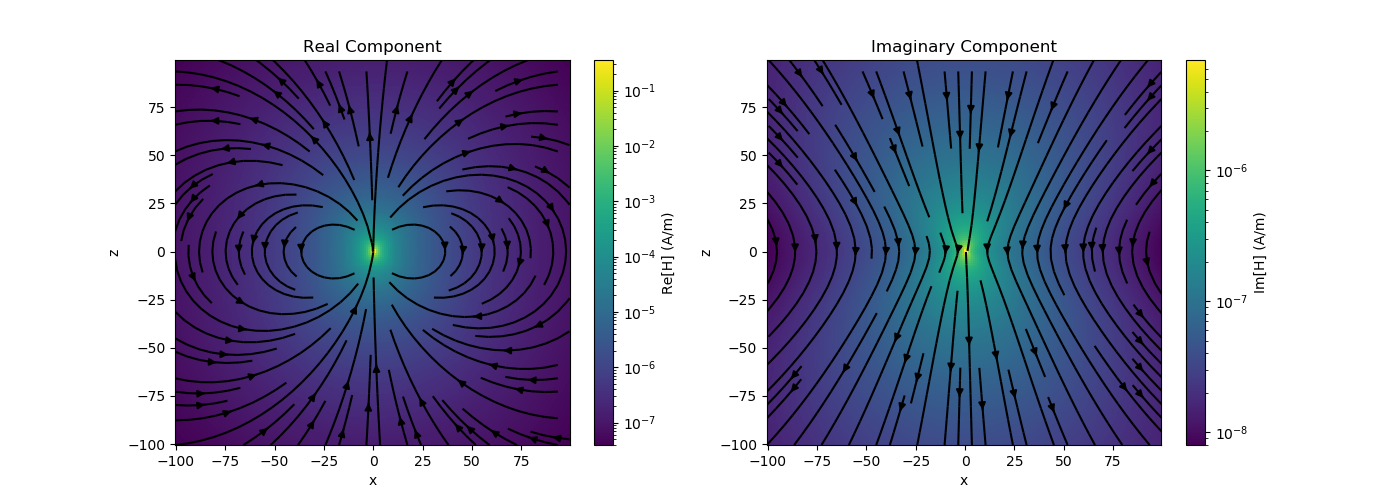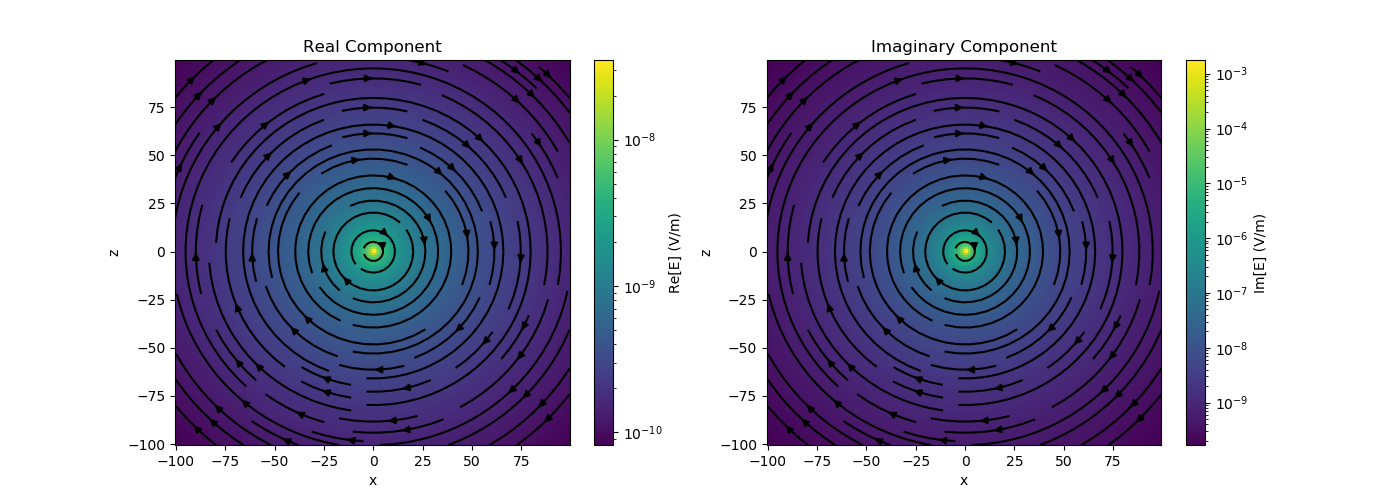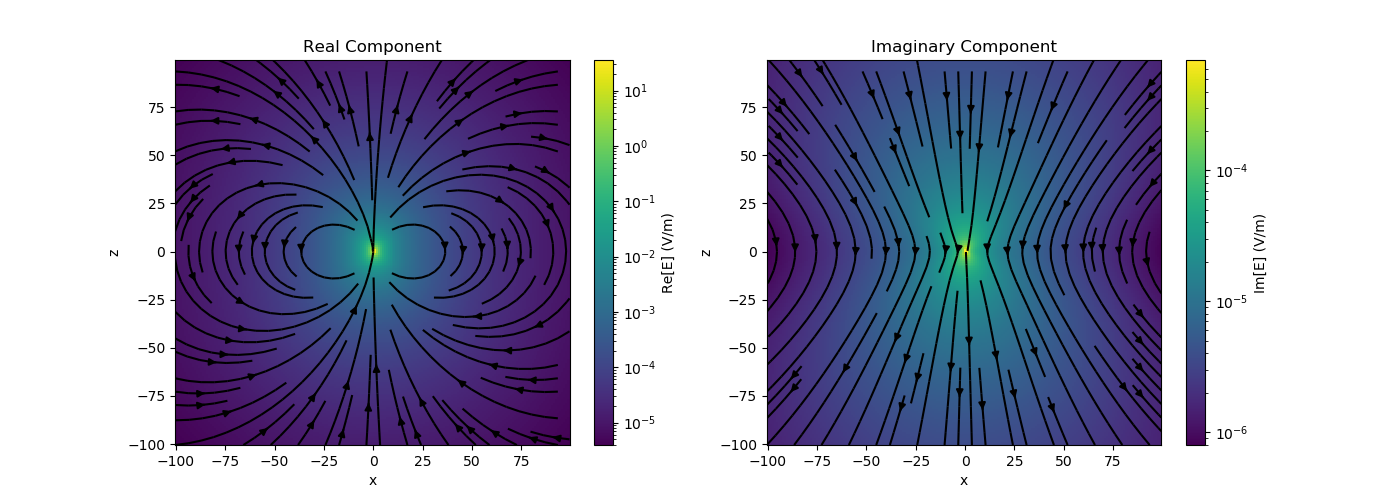Note
Click here to download the full example code
Simulation with Analytic FDEM Solutions¶
Here, the module SimPEG.electromagnetics.analytics.FDEM is used to simulate harmonic electric and magnetic field for both electric and magnetic dipole sources in a wholespace.
Import modules¶
import numpy as np
from SimPEG import utils
from SimPEG.electromagnetics.analytics.FDEM import (
ElectricDipoleWholeSpace,
MagneticDipoleWholeSpace,
)
import matplotlib.pyplot as plt
from matplotlib.colors import LogNorm
Magnetic Fields for a Magnetic Dipole Source¶
Here, we compute the magnetic fields for a harmonic magnetic dipole source in the z direction. Based on the geometry of the problem, we expect magnetic fields in the x and z directions, but none in the y direction.
# Defining electric dipole location and frequency
source_location = np.r_[0, 0, 0]
frequency = 1e3
# Defining observation locations (avoid placing observation at source)
x = np.arange(-100.5, 100.5, step=1.0)
y = np.r_[0]
z = x
observation_locations = utils.ndgrid(x, y, z)
# Define wholespace conductivity
sig = 1e-2
# Compute the fields
Hx, Hy, Hz = MagneticDipoleWholeSpace(
observation_locations,
source_location,
sig,
frequency,
moment="Z",
fieldType="h",
mu_r=1,
eps_r=1,
)
# Plot
fig = plt.figure(figsize=(14, 5))
hxplt = Hx.reshape(x.size, z.size)
hzplt = Hz.reshape(x.size, z.size)
ax1 = fig.add_subplot(121)
absH = np.sqrt(Hx.real ** 2 + Hy.real ** 2 + Hz.real ** 2)
pc1 = ax1.pcolor(x, z, absH.reshape(x.size, z.size), norm=LogNorm())
ax1.streamplot(x, z, hxplt.real, hzplt.real, color="k", density=1)
ax1.set_xlim([x.min(), x.max()])
ax1.set_ylim([z.min(), z.max()])
ax1.set_title("Real Component")
ax1.set_xlabel("x")
ax1.set_ylabel("z")
cb1 = plt.colorbar(pc1, ax=ax1)
cb1.set_label("Re[H] (A/m)")
ax2 = fig.add_subplot(122)
absH = np.sqrt(Hx.imag ** 2 + Hy.imag ** 2 + Hz.imag ** 2)
pc2 = ax2.pcolor(x, z, absH.reshape(x.size, z.size), norm=LogNorm())
ax2.streamplot(x, z, hxplt.imag, hzplt.imag, color="k", density=1)
ax2.set_xlim([x.min(), x.max()])
ax2.set_ylim([z.min(), z.max()])
ax2.set_title("Imaginary Component")
ax2.set_xlabel("x")
ax2.set_ylabel("z")
cb2 = plt.colorbar(pc2, ax=ax2)
cb2.set_label("Im[H] (A/m)")

Electric Fields for a Magnetic Dipole Source¶
Here, we compute the electric fields for a harmonic magnetic dipole source in the y direction. Based on the geometry of the problem, we expect rotational electric fields in the x and z directions, but none in the y direction.
# Defining electric dipole location and frequency
source_location = np.r_[0, 0, 0]
frequency = 1e3
# Defining observation locations (avoid placing observation at source)
x = np.arange(-100.5, 100.5, step=1.0)
y = np.r_[0]
z = x
observation_locations = utils.ndgrid(x, y, z)
# Define wholespace conductivity
sig = 1e-2
# Predict the fields
Ex, Ey, Ez = MagneticDipoleWholeSpace(
observation_locations,
source_location,
sig,
frequency,
moment="Y",
fieldType="e",
mu_r=1,
eps_r=1,
)
# Plot
fig = plt.figure(figsize=(14, 5))
explt = Ex.reshape(x.size, z.size)
ezplt = Ez.reshape(x.size, z.size)
ax1 = fig.add_subplot(121)
absE = np.sqrt(Ex.real ** 2 + Ey.real ** 2 + Ez.real ** 2)
pc1 = ax1.pcolor(x, z, absE.reshape(x.size, z.size), norm=LogNorm())
ax1.streamplot(x, z, explt.real, ezplt.real, color="k", density=1)
ax1.set_xlim([x.min(), x.max()])
ax1.set_ylim([z.min(), z.max()])
ax1.set_title("Real Component")
ax1.set_xlabel("x")
ax1.set_ylabel("z")
cb1 = plt.colorbar(pc1, ax=ax1)
cb1.set_label("Re[E] (V/m)")
ax2 = fig.add_subplot(122)
absE = np.sqrt(Ex.imag ** 2 + Ey.imag ** 2 + Ez.imag ** 2)
pc2 = ax2.pcolor(x, z, absE.reshape(x.size, z.size), norm=LogNorm())
ax2.streamplot(x, z, explt.imag, ezplt.imag, color="k", density=1)
ax2.set_xlim([x.min(), x.max()])
ax2.set_ylim([z.min(), z.max()])
ax2.set_title("Imaginary Component")
ax2.set_xlabel("x")
ax2.set_ylabel("z")
cb2 = plt.colorbar(pc2, ax=ax2)
cb2.set_label("Im[E] (V/m)")

Electric Field from a Harmonic Electric Current Dipole Source¶
Here, we compute the electric fields for a harmonic electric current dipole source in the z direction. Based on the geometry of the problem, we expect electric fields in the x and z directions, but none in the y direction.
# Defining electric dipole location and frequency
source_location = np.r_[0, 0, 0]
frequency = 1e3
# Defining observation locations (avoid placing observation at source)
x = np.arange(-100.5, 100.5, step=1.0)
y = np.r_[0]
z = x
observation_locations = utils.ndgrid(x, y, z)
# Define wholespace conductivity
sig = 1e-2
# Predict the fields
Ex, Ey, Ez = ElectricDipoleWholeSpace(
observation_locations,
source_location,
sig,
frequency,
moment=[0, 0, 1],
fieldType="e",
mu_r=1,
eps_r=1,
)
# Plot
fig = plt.figure(figsize=(14, 5))
explt = Ex.reshape(x.size, z.size)
ezplt = Ez.reshape(x.size, z.size)
ax1 = fig.add_subplot(121)
absE = np.sqrt(Ex.real ** 2 + Ey.real ** 2 + Ez.real ** 2)
pc1 = ax1.pcolor(x, z, absE.reshape(x.size, z.size), norm=LogNorm())
ax1.streamplot(x, z, explt.real, ezplt.real, color="k", density=1)
ax1.set_xlim([x.min(), x.max()])
ax1.set_ylim([z.min(), z.max()])
ax1.set_title("Real Component")
ax1.set_xlabel("x")
ax1.set_ylabel("z")
cb1 = plt.colorbar(pc1, ax=ax1)
cb1.set_label("Re[E] (V/m)")
ax2 = fig.add_subplot(122)
absE = np.sqrt(Ex.imag ** 2 + Ey.imag ** 2 + Ez.imag ** 2)
pc2 = ax2.pcolor(x, z, absE.reshape(x.size, z.size), norm=LogNorm())
ax2.streamplot(x, z, explt.imag, ezplt.imag, color="k", density=1)
ax2.set_xlim([x.min(), x.max()])
ax2.set_ylim([z.min(), z.max()])
ax2.set_title("Imaginary Component")
ax2.set_xlabel("x")
ax2.set_ylabel("z")
cb2 = plt.colorbar(pc2, ax=ax2)
cb2.set_label("Im[E] (V/m)")

Magnetic Field from a Harmonic Electric Dipole Source¶
Here, we compute the magnetic fields for a harmonic electric current dipole source in the y direction. Based on the geometry of the problem, we expect rotational magnetic fields in the x and z directions, but no fields in the y direction.
# Defining electric dipole location and frequency
source_location = np.r_[0, 0, 0]
frequency = 1e3
# Defining observation locations (avoid placing observation at source)
x = np.arange(-100.5, 100.5, step=1.0)
y = np.r_[0]
z = x
observation_locations = utils.ndgrid(x, y, z)
# Define wholespace conductivity
sig = 1e-2
# Predict the fields
Hx, Hy, Hz = ElectricDipoleWholeSpace(
observation_locations,
source_location,
sig,
frequency,
moment=[0, 1, 0],
fieldType="h",
mu_r=1,
eps_r=1,
)
# Plot
fig = plt.figure(figsize=(14, 5))
hxplt = Hx.reshape(x.size, z.size)
hzplt = Hz.reshape(x.size, z.size)
ax1 = fig.add_subplot(121)
absH = np.sqrt(Hx.real ** 2 + Hy.real ** 2 + Hz.real ** 2)
pc1 = ax1.pcolor(x, z, absH.reshape(x.size, z.size), norm=LogNorm())
ax1.streamplot(x, z, hxplt.real, hzplt.real, color="k", density=1)
ax1.set_xlim([x.min(), x.max()])
ax1.set_ylim([z.min(), z.max()])
ax1.set_title("Real Component")
ax1.set_xlabel("x")
ax1.set_ylabel("z")
cb1 = plt.colorbar(pc1, ax=ax1)
cb1.set_label("Re[H] (A/m)")
ax2 = fig.add_subplot(122)
absH = np.sqrt(Hx.imag ** 2 + Hy.imag ** 2 + Hz.imag ** 2)
pc2 = ax2.pcolor(x, z, absH.reshape(x.size, z.size), norm=LogNorm())
ax2.streamplot(x, z, hxplt.imag, hzplt.imag, color="k", density=1)
ax2.set_xlim([x.min(), x.max()])
ax2.set_ylim([z.min(), z.max()])
ax2.set_title("Imaginary Component")
ax2.set_xlabel("x")
ax2.set_ylabel("z")
cb2 = plt.colorbar(pc2, ax=ax2)
cb2.set_label("Im[H] (A/m)")

Total running time of the script: ( 0 minutes 10.391 seconds)